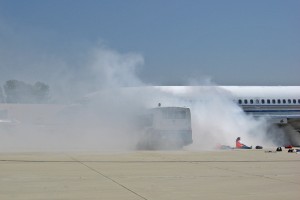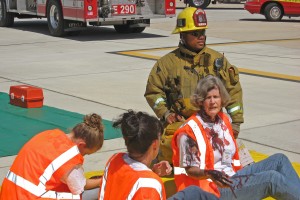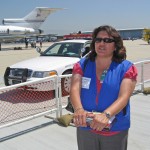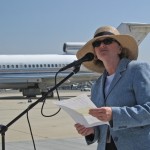By Harlis Brend
On June 11, a full-scale simulated aircraft accident tested the emergency response capabilities of Van Nuys Airport (VNY). The air exercise was staged on the ramp area adjacent to the Los Angeles Fire Operations and General Services facilities at the north end of the airport. The VNY AIREX tested the emergency responders and mutual aid providers in a real-time environment, requiring the mobilization of equipment and personnel. According to Selena Birk, VNY airport manager, with more than 300 participants, including volunteers playing mock victims, the exercise gave individuals and agencies the opportunity to practice and refine their emergency procedures. Participants included LAFD, LAPD, Los Angeles World Airways divisions—including LAX Airfield Operations, LAX Police Department, Construction and Maintenance, Public and Community Relations, Risk Management, Emergency Preparedness—Federal Aviation Administration, National Transportation Safety Board, American Red Cross, local hospital emergency rooms, medical
units, ambulance services and other mutual aid organizations.
The VNY AIREX simulation, featuring an aircraft accident involving other vehicles, interrupted airport operations and public access to streets adjacent to the airport. The scenario had a Boeing B-727, attempting takeoff on runway 16R, colliding with a limousine that had strayed onto the active runway. A secondary accident was precipitated when the aircraft wreckage broke through the airport perimeter onto a public street and collided with a Metro Transit Authority bus. The accident nearly destroyed the limousine, the B-727 caught fire and the bus received minor damage. The staged accident scene on the ramp included a static B-727-200 aircraft, a debris field of aircraft parts leading to the wrecked limousine, smoke to simulate the aircraft explosion and fire, and victims in makeup appropriate to their assigned medical condition. A public address system was located in an adjacent viewing area; an announcer kept spectators and the press informed of the progress of the simulation as events were occurring.

Emergency responders attend to victims. The injured are sorted onto different colored tarps according to the urgency of their medical needs.
When the crash alarm sounded, airport operations and police arrived on the scene to establish a security perimeter, followed by the airport firefighting equipment and the medical triage responders. LAPD blocked traffic on the “adjacent” street, authorities notified the FAA and the airport was declared closed. As the simulation progressed, the firefighters took up positions around the burning aircraft while medical responders attended to the victims. With the crash scene stabilized and the victims attended to, Diana Sanchez, airport public relations director, held a mock news conference that also included spokespersons from the fire department and police and medical personnel.
The medical teams set up a triage area at a safe distance from the wreck in order to prioritize victims’ treatment based on the severity of their conditions. Victims in need of critical attention are immediately transported to the hospital before those with less serious injuries. Large red, yellow and green tarps on the ground defined a location for three triage categories.
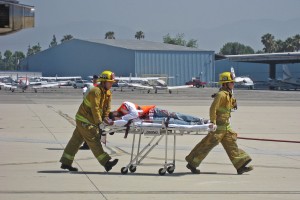
Medical responders rush a seriously injured “patient” to an ambulance for transportation to a local hospital.
The red tarp signified immediate/priority 1: victims in critical condition and in danger of dying without immediate assistance are evacuated by medevac if available, or by ambulance, for advanced medical care at once or within one hour.
For yellow, or delayed/priority 2, medical evacuation can be delayed until the transportation of all red-level victims is completed. These victims are in stable condition, but require medical assistance.
In the case of green, or minor/priority 3, medical evacuation can be delayed until the transportation of all red and yellow level victims is completed. These people will not need advanced medical care for at least several hours. They’re able to walk and may only require bandages and antiseptic.
The Voluntary Emergency Support Team was activated during the exercise. VEST is an emergency family support team for the airport that provides a means of supporting families as they’re waiting to hear about their loved ones in the first few hours following a crash at or near Van Nuys Airport. The Citation jet crash at VNY about a year ago prompted the organization of this support team. Los Angeles World Airports has provided a safe location for the VEST team to operate and sequester the families in the event of an incident.
Two mental health professionals with experience working major aviation disasters, Dr. Phil Jones and Dr. Bonita Wirth, provided training for the team volunteers. The team members have agreed to drop everything if the airport contacts them in case of an emergency, and will provide immediate support as needed.
“This is a very exciting program that we hope we’ll never need,” stated VEST volunteer Dan Katz during a recent meeting of the VNY Propeller Association.
The Van Nuys VEST organization is the first of its kind anywhere in the country.
Objectives of the test
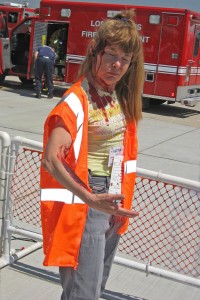
“It felt very realistic!” said victim volunteer Judy Coates of her experience at the simulated crash scene.
The objectives established for the VNY AIREX 2008 included “testing the efficiency of inter-agency and inter-departmental planning and coordination in managing an airport disaster; testing current procedures of the Airport Emergency Plan using responses under a unified command and satisfying federal requirements; and determining the strengths and weaknesses in the integration of response resources with the goal toward improving individual agency and overall emergency response.”
Since Van Nuys Airport is a general aviation airport without scheduled air carrier service, it’s not regulated under CFR Part 139. While the FAA doesn’t certificate GA airports under Part 139, the regulation contains many safety procedures and practices the FAA recommends for use at all airports. VNY is dedicated to emergency preparedness and will periodically conduct full-scale emergency exercises.
“We had no real problems; the key was for everyone to know who the ‘players’ were,” stated Diana Sanchez, public and community relations director, during a debriefing following AIREX. Regarding how the agencies handled family assistance, Sanchez stated, “No major changes, but we’re looking at working more closely with VEST.”
“The purpose was to help us practice and make sure we are able to handle emergencies in a smoother fashion,” Sanchez said. “Thankfully, emergencies don’t happen every day, but we want to make sure that we are prepared when they happen. It was very successful.”
- Diana Sanchez, public and community relations director, conducted a preliminary news conference.
- After triage by medical professionals, all immediate (red) and delayed (yellow) category patients are evacuated in order according to the severity of their injuries.
- VNY Airport Manager Selena Birk presented an outline for the exercise and thanked the multitude of people involved in planning the event, including the LAFD, LAPD, FAA and NTSB.












